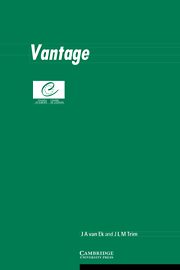Book contents
- Frontmatter
- Contents
- Introduction
- 1 The objective: levels of specificity
- 2 The objective: general characterisation
- 3 The objective: extended characterisation
- 4 The objective: components of the specification
- 5 Language functions
- 6 General notions
- 7 Topic-related tasks and lexicon
- 8 Discourse structure and verbal exchange
- 9 Dealing with texts: reading and listening
- 10 Writing
- 11 Sociocultural competence
- 12 Compensation strategies
- 13 Learning to learn
- 14 Degree of skill
- 15 By-products
- APPENDICES
- A Lexical exponents of specific notions for Vantage
- B Grammatical summary
B - Grammatical summary
Published online by Cambridge University Press: 28 January 2010
- Frontmatter
- Contents
- Introduction
- 1 The objective: levels of specificity
- 2 The objective: general characterisation
- 3 The objective: extended characterisation
- 4 The objective: components of the specification
- 5 Language functions
- 6 General notions
- 7 Topic-related tasks and lexicon
- 8 Discourse structure and verbal exchange
- 9 Dealing with texts: reading and listening
- 10 Writing
- 11 Sociocultural competence
- 12 Compensation strategies
- 13 Learning to learn
- 14 Degree of skill
- 15 By-products
- APPENDICES
- A Lexical exponents of specific notions for Vantage
- B Grammatical summary
Summary
This summary presents a classified inventory of the grammatical categories, elements and structures which figure as exponents of the functional and notional categories set out in Chapters 5, 6, 7 and 8 and in Appendix A.
The summary is largely identical with Appendix B of Threshold 1990, the grammatical content of which is in fact very rich. A learner who is able to exploit fully and freely the lexical and grammatical resources required for the realisation of the range of language functions and, particularly, general notions set out there will have progressed well beyond what is to be expected after two years' part-time study. In progressing from Threshold to Vantage learners are expanding their range of available language resources largely in the lexical field. In the area of grammar, development is rather in respect of the relaxation of constraints on the use of resources. Many grammatical structures which at Threshold level are found only in fixed formulaic expressions will at Vantage level be available for more generalised use, leading to greater freedom and flexibility in expression and in understanding. When using those already generalisable at Threshold level, Vantage level learners will have attained a greater ability to satisfy the criteria of accuracy and fluency. These advances will apply to both speech and writing, though in the nature of things writing, which allows more time for formulation and self-editing, will enable a learner to reflect, to consult works of reference and use a more complex language with greater accuracy.
- Type
- Chapter
- Information
- Vantage , pp. 141 - 175Publisher: Cambridge University PressPrint publication year: 2000



